|
| OO Scale | N Scale | G Scale | Z Scale | HO Scale | Slot Cars & R⁄C |
| |||||||
|
|||||||
| Home Page | |||||||
| BUY GIFT VOUCHERS | |||||||
| Products | |||||||
| Latest News | |||||||
| RIGHT LINES | |||||||
| Bargains | |||||||
| Downloads | |||||||
| Events | |||||||
| Careers & Jobs | |||||||
| Carriage Services | |||||||
| About Us | |||||||
| Contact Us | |||||||
| Pay Us A Visit | |||||||
| Meet The Staff | |||||||
| Links | |||||||
| SHOPPING BASKET |
Your shopping basket is empty. To add an item, click the "Buy" button
| YOUR ACCOUNT | ||
|
||||
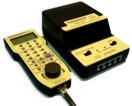 |
||||
| Prodigy Advance Digital System |
||||
| Cased Controllers |
||||
| Panel Mount Controllers |
||||
| Walkabout Controllers |
||||
| Modules & Transformers |
||||
| Scenics & Accessories |
||||
| Wiring & Electrical Components |
||||
| Tiny Signs | ||||
| Tools | ||||
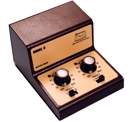 |
||||
| O Scale | Wargaming | Architectural | Narrow Gauge | Tools+ | ||
German Railways after 1920

STUART JORDAN looks at the history of German railways from 1920 to the present day.
Before World War One the German railway system was a collection of different companies each serving the particular state that they were in, run autonomously to each other. In 1918 the German Empire fell, and the country became a republic. This lead to the railway system being nationalised.
Deutsche Reichsbahn-Gesellschaft: 1920 - 1937
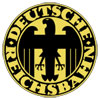
The Deusche Reichseisenbahnen (German Imperial Railway) was formed on 1st April 1920. The Weimar Republic (so called because the first assembly of the government in 1919 was in the town of Weimar) took control of the states' railways in the following areas; Baden, Meckleberg, Oldenberg, Bavaria, Saxony, Wurtenberg, and Prussia.
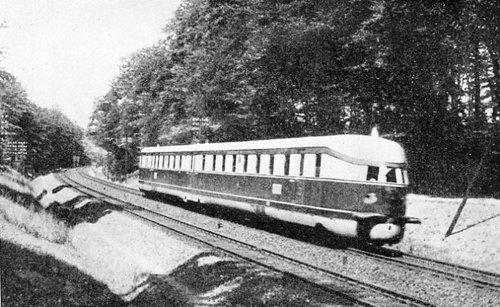
The "Flying Hamburger"
At the end of the war the Treaty of Versailles set out Germany's required reparations, and the Dawes Plan was introduced as a way to manage these payments. One part of the Dawes Plan was to use the profits from the state railway to pay back reparations. On 12th February 1924 the Deutsche Reichsbahn-Gesellschaft (DRG) was created as a state enterprise. Unfortunately the plan didn't work as intended, with the Great Depression severely hitting inter-war Germany and putting a large amount of strain on the DRG.
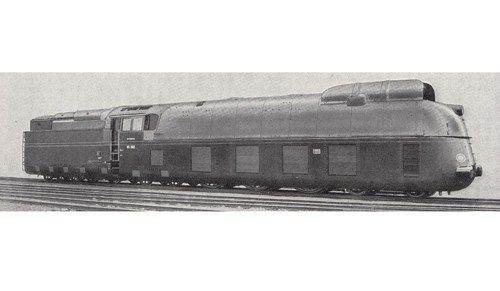
DRG Class 05 Locomotive manufactured by Borsig.
What the DRG did achieve was standardisation. Before being nationalised each regional railway would have their own locomotives, but now under one company a level of standardisation was attained, but this was also hampered by the poor economy. Despite this there were some achievements such as the Flying Hamburger high-speed train in the late 1930s, which had a top speed of 99mph (160kph) on the Berlin-Hamburg line, and the streamlined Borsig steam engines, which reflected the design aesthetics of the time.
Deutsche Reichsbahn: 1937 - 1949
From 10th February 1937 the DRG was placed under Reich sovereignty and renamed the Deutsche Reichsbahn. In 1938 the DR absorbed the Austrian railway system after the Anschluss (German annexation of Austria). During the period up to the end of World War Two the DR was used for the rapid movement of troops.
The build-up to the German invasion of Russia was the largest troop deployment by rail in history. The national railway services of occupied countries were also run by the DR apart from in Russia, where the Russian Broad Gauge was not compatible with the rest of the European network. As Russian forces withdrew they destroyed stock, denying its use to the Germans – who had to re-lay around 10,000 miles of track.
The DR also played its part in the Holocaust, transporting thousands of people to concentration camps. This period is a black stain on the history of the railway as those being transported were often charged for their journey, with the profits going to Deutsche Reichsbahn.
When Germany surrendered in 1945 the Potsdam Agreement split the country into administrative zones, each looked after by the USA, the UK, France, and Russia with each of these countries overseeing the running of the railways in each zone. In 1949 the Soviet Zone became a self-declared state, and the country was split into East and West Germany. The railways in East Germany retained the title of Deutsche Reichsbahn – the three railway systems in the west had already merged into the Deutsche Bundesbahn.
Deutsche Bundesbahn - West Germany: 1949 - 1994

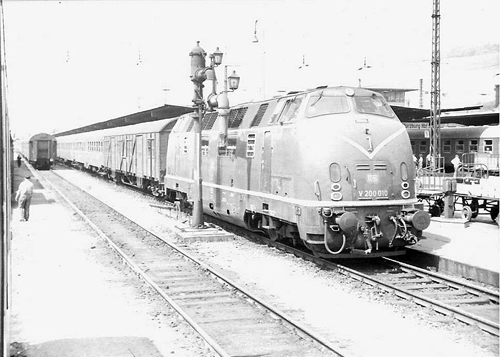
V200 Locomotive pulling a passenger train in West Germany in the early 1960s.
The first task for the DB was rebuilding the damage done to the network during the war. West Germany was not subject to war reparations, so the influx of capital made reconstruction a lot easier than in the east. New stock was built, and railbus services increased to stave off competition from motor transport. With increased electrification steam was phased out by 1977, and new trains such as the Trans-Europ Express were introduced.
After the TGV was introduced in France, DB looked at how to provide West Germany with a high-speed train. The solution was the Intercity-Express (ICE), and new high-speed lines were built.
Deutsche Reichsbahn - East Germany: 1949 - 1994

DR was the largest employer in East Germany. Electrification was much slower than in West Germany, with much of the previously electrified network equipment being claimed by Russia as reparations. Steam was relied on for much longer, until 1988, due to the relative cheapness of using Russian-made diesel locomotives.
Deutsche Bahn: 1994 - Present

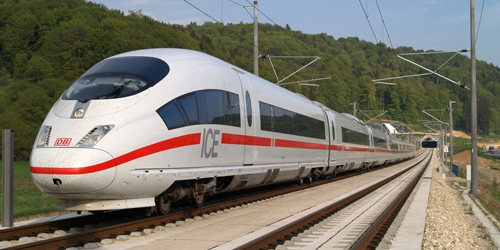
DB ICE-3 High-Speed Train (Photo: DB).
Both companies continued separately for four years after German reunification in 1990, but merged in 1994 to become Deutsche Bahn AG, owned and run by the German government. In 1999 DB went through what was called Bahnreform, with the company assets split into five groups -
- DB Reise & Touristik AG (Long distance passenger services)
- DB Regio AG (Regional passenger services)
- DB Cargo AG (Freight – later renamed Railion AG)
- DB Netz AG (Infrastructure)
- DB Station & Service AG (Stations)
In December 2007 DB departments were again reformed into:
- DB Bahn (Passenger)
- DB Shenker (Logistics)
- DB Netze (Infrastructure and stations)
DB International Assets
In 2010 DB acquired Arriva, a multinational transport company that runs train and bus services in twelve countries. UK assets include Arriva Trains Wales, Chiltern Railways, Crosscountry, Grand Central Northern, and Arriva Rail London which runs Overground services. DB Shenker also run Transfesa, a freight transport company based in Madrid, and the UK arm of DB Cargo – which used to be EWS. DB Shenker also run the British Royal Train.
DB have also branched out into other international markets, running Trans-Eurasia Logistics as a joint venture with Russian Railways, to bring container trains from China to Germany. They are also assisting the California High-Speed Rail Authority (CHSRA) on the planning, design and implementation of the high speed line in that state.
Modelling German Railways

A good place to start is the Peco Guide to Modelling German Railways, which is packed with information on all eras and scales of modelling layouts in Germany.
Manufacturers who produce German railway items include Roco, Fleischmann, Marklin, Trix, and Piko.
|
We are always looking to make improvements to our website to try and improve the quality of your visit. We would welcome your feedback and suggestions, so please do not hesitate to e-mail our webmaster with your comments. Alternatively call us on 01903 884488.
Home Cookies Privacy Statement Terms & Conditions Site Map Site Guide
WEEE Regulations Glossary Careers & Jobs
Tel – +44 (0) 1903 884488 Fax – +44 (0) 1903 884377 E-Mail us – click here
Gaugemaster.com is a trading name of Gaugemaster Controls Ltd.
Registered in England No. 2714470, Registered office:
Gaugemaster House, Ford Road
Arundel, West Sussex, BN18 0BN, United Kingdom
VAT Reg. No. 587 8089 71
Copyright © 2003-2014 Gaugemaster Controls Ltd. All Rights Reserved.
















